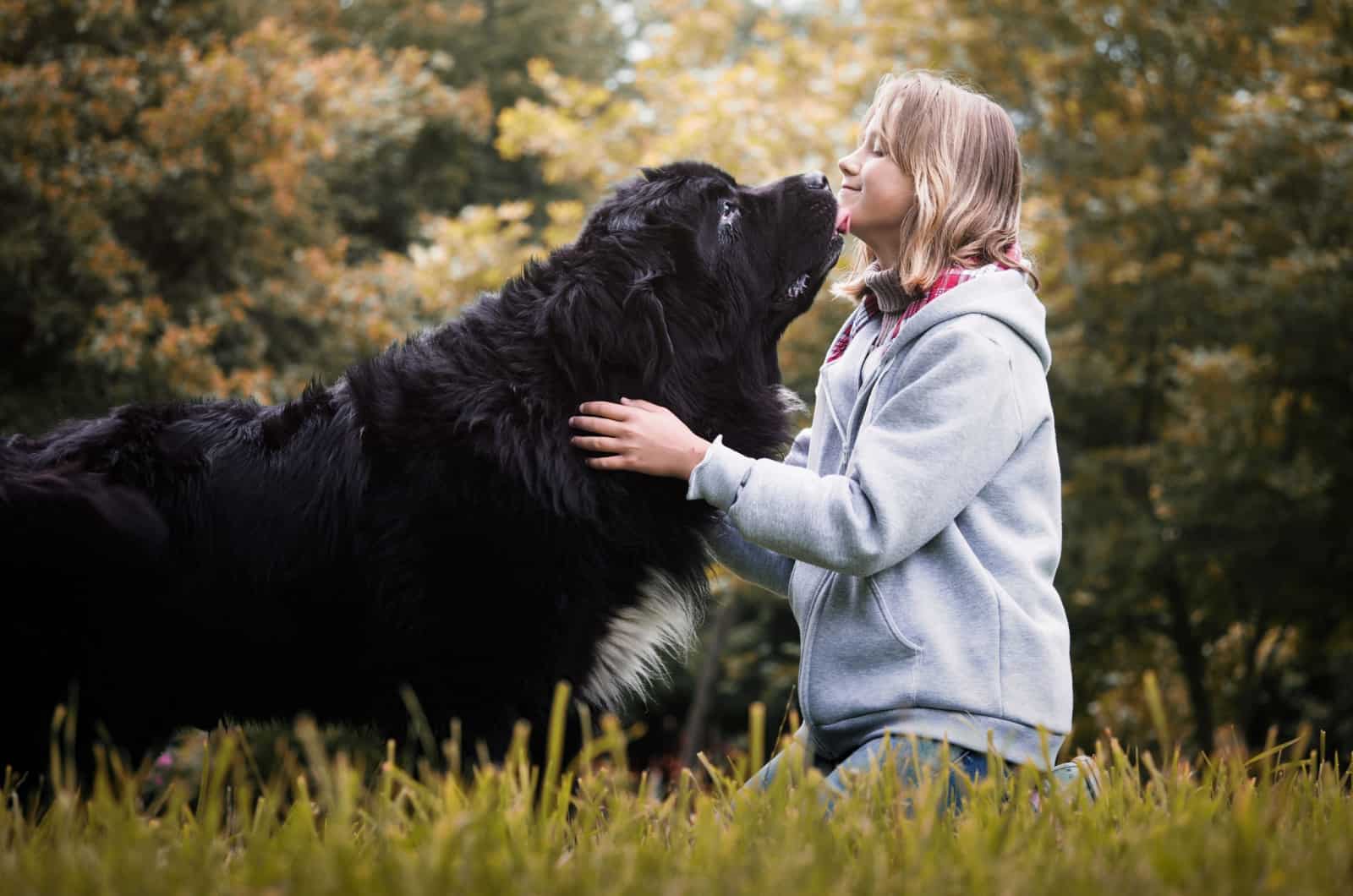Being a giant dog breed, the Newfoundland dog needs particularity in its diet. Making your own way through feeding regimes is absolutely viable but following some guidelines, at least while your Newf is a puppy, is highly recommended.
We have created a Newfoundland feeding chart and a growth chart as an estimate of how much your Newfoundland puppy should weigh throughout its growing period.
There is a possibility that your puppy will be a rebel and be a bit heavier or lighter than what the chart says, but the ranges are comprehensive and you will find them useful regardless.
Keep in mind that the first month is a “mother only” period, and feeding your puppy with anything other than its mothers milk is not recommended. You should definitely consult a veterinarian before deciding.
Newfoundland Feeding Chart (Amount of Food by Age)
[table id=581 /]
Newfoundland Dog Growth Chart
[table id=582 /]
Feeding Chart Breakdown and More
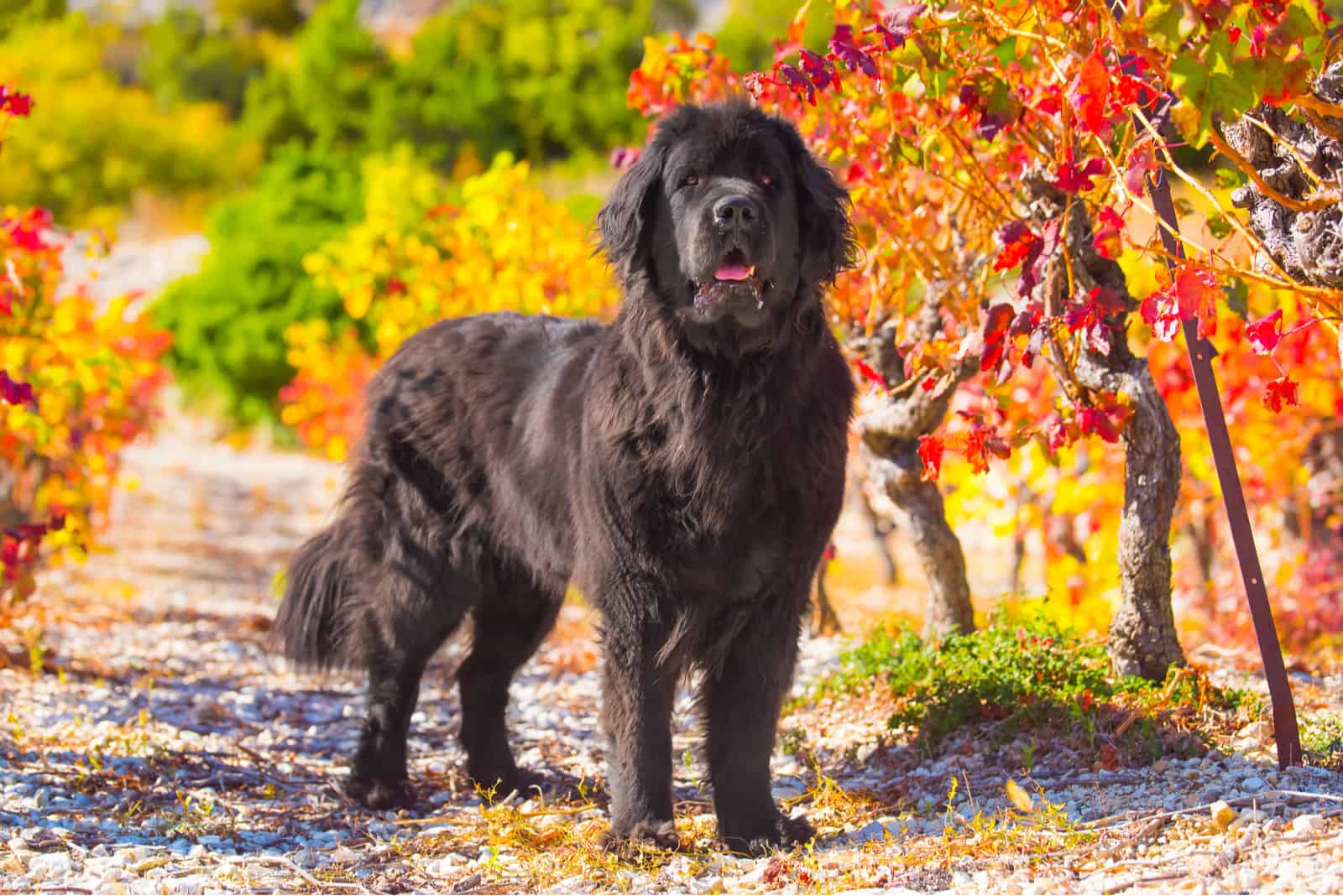
Alright. So, according to the Newfoundland growth chart, the growth of a Newfoundland dog is rather fast. There are some slower periods, like 7 – 9 months. The explanation: their genetics kick in to keep the giant stature of an adult Newf from putting too much load on their bones too fast.
Cups of food to lift the mood!
Grab an 8 ounce cup and follow our chart to properly distribute meals throughout the day. As previously mentioned, the chart is an estimate of what your puppy or adult Newfoundland dog should eat.
Your mileage may vary but we recommend asking the breeder you got your puppy from or a veterinarian about what is ideal. Every litter is different, and every dog in it, a unique character.
This giant breed has an additional perk while still in “large breed puppy” mode. The puppy can eat adult food as soon as it reaches two months or 8 weeks of age. They are GIANT puppies with ENORMOUS mouths. They can eat a lot as well!
The exact Newf puppy you brought home will very soon show you its true appetite for destruction. Maybe it surprises you with a lazy bag lifestyle or insistence on being a lap dog. Nothing more convenient than a paper thin set of legs.
To avoid such fate (having a 150 pound dog doing an impression of a Pomeranian) we listed some good eating habits to avoid health issues like bloat and obesity, with a little doggy brain stimulation.
Balancing Dog Food And Activity Levels
Levels of activity in both puppies and adults vary greatly. This determines what diet changes you should apply. If your dog is very active, consider adding a quarter or half a cup of extra food in one of the three meals during the day.
Equally, if you see that your dog is less active, has put on some extra weight, and seems to always be hungry, simply lower the dosage by an appropriate amount. Keep in mind that raising your dog’s activity level is preferable to reducing food intake.
Last, but not least, the feeding chart uses average weight values for the Newfoundland breed. This means that they should suit both male and female dogs. With a twiddle here and there, you should be able to hit the right amount of food for either.
Instilling Good Eating Habits In Your Newfoundland Puppy
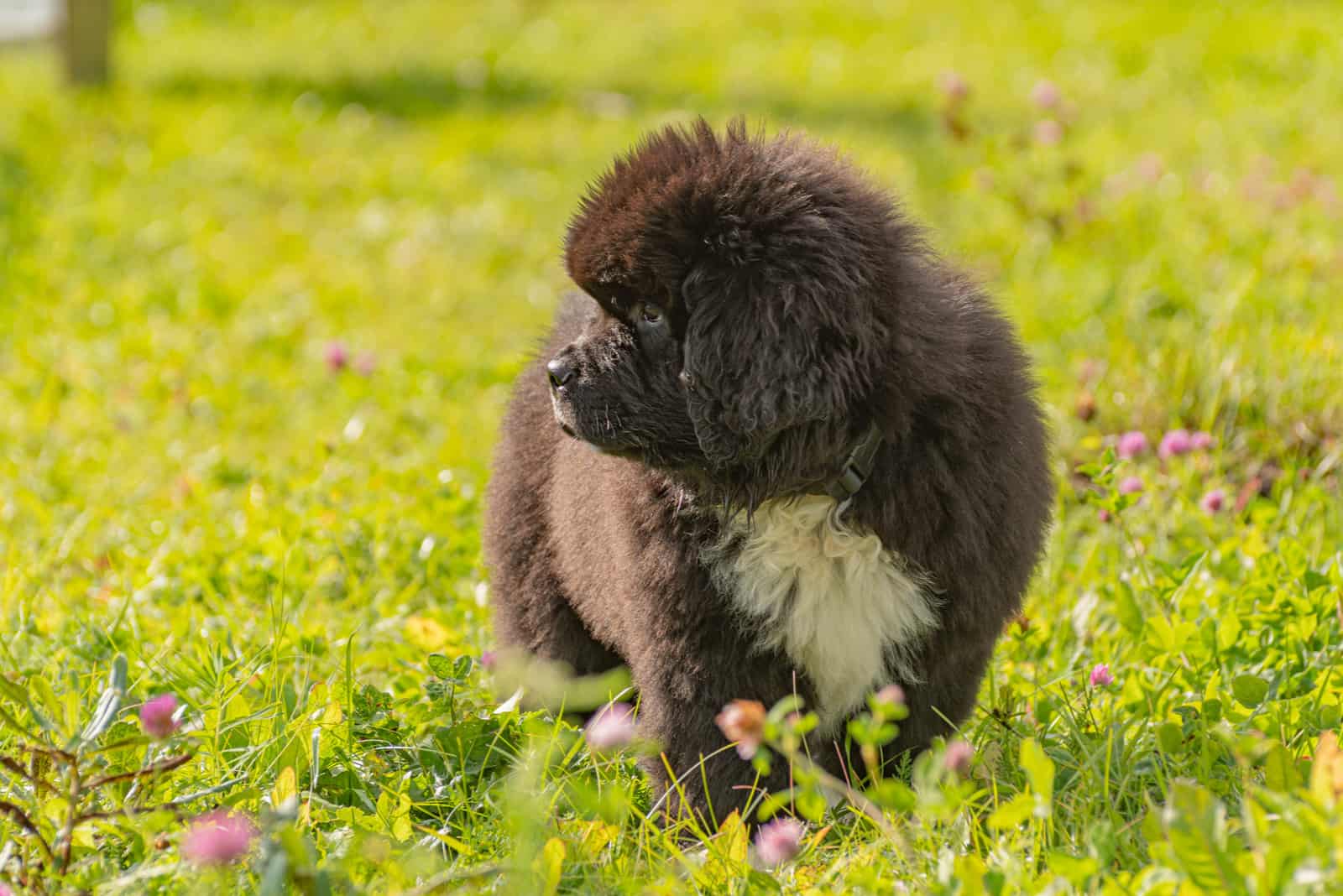
As humans, we have our life pretty ironed out. There is a time to wake, sleep, work, play, socialize and, most importantly, indulge ourselves in some exquisite culinary feat.
Let us start off with some of the best habits you can instill in your puppy while making your own life easier.
1. Let Your Newfie Earn Its Food
We easily succumb to their cute faces and high-pitched barks and whines. Puppies are, obviously, masters of manipulation.
This is why we need to be strong! Do not give your Newfie puppy food whenever it suggests so. While, in theory, we assume it will be a piece of cake, the sounds a puppy can produce become an annoyance very fast. They are relentless.
1. Puzzle Feeder
Desperately accommodating the puppy’s craving only leads to weight gain. One thing you can do is use a puzzle feeder. Food drive dominates a puppy’s life, and using it with the right tool can only boost your Newfoundland puppy’s smarts!
2. Food As Reward After Mental Or Physical Activity
There is always the good old, hands on, reward approach. Teach your dog to sit, heel, lie down, roll, bring you a bag of snacks, do the laundry and more!
With a Newfoundland dog you are probably stuck with the more basic obedience training, not because they are not smart but because they cannot be bothered. Stubborn little giants…
3. Snuffle Mat Pandemonium
If you are looking to simply teach your dog patience when getting food while still controlling how fast it eats, the snuffle mat is a great option. Digging, licking and biting are all allowed here! Strips of fake grass on top of treats or food? Say no more!
2. Newfoundland Puppy Appetite Problems Or?
A Newfoundland puppy not eating probably scares us all. After all, that is their favorite activity. This could be happening for a couple of reasons.
One that is fairly common is stress. What on Earth could possibly stress out a wiggly little puppy? A change of environment is a common issue. This is particularly pronounced after the pup is separated from its mother, and the best remedy is love and care. You have got to earn your puppy’s trust.
Another possibility is food flavor. Humans are very picky eaters and puppy newfies can be too. There are flavor enhancers for your pets too, and, best of all, they are completely safe. A little bit of spice can be nice!
There are no special breed puppy foods, and working out the best tasting dishes for your canine is a fun process of bonding.
Important:
If your puppy is losing weight or skips a couple meals in a row, take it to a veterinarian. There could be underlying health issues. See our chart for weight references at particular months of age.
Food allergies can cause your dog not to eat a particular brand or type of food. Avoid these foods as they can cause further health problems in your puppy.
Read Also: Why My Dog Won’t Eat His Food But Will Eat Treats?
3. Manage Your Puppy’s And Adult Dog’s Weight
Obesity is a common problem with animals. This problem is especially dangerous for large and giant dog breeds. Hearing your puppy whine and cry at night in his crate without any apparent reason can mean two things: it wants company or FOOD.
Providing a well-rounded diet for your new Newfoundland puppy is necessary, but beware of overfeeding. Hip dysplasia is common in giant breed dogs such as the Newfoundlander.
Other than through selective inbreeding, hip dysplasia can be caused by obesity. Any extra weight on your Newfie will put more strain on its joints and bones, causing stretching, unnatural compression, and cartilage wear and tear.
The puppy’s weight should be regularly checked and compared to the growth chart. Being initially so little with the potential to become giant means RAPID growth.
Your puppy will become an adult Newfoundland in a heartbeat and you will want to make sure to nurture this speedy process.
A Newfoundland dog is considered an adult when it reaches the age of two years. This means that it should not grow after that period, but every dog has its own plan so take this with a grain of salt.
This, however, does not mean you should neglect its needs without reassessing the existing routine. Many factors can contribute to a change in an adult dog’s feeding plan. Activity level, health condition, and food quality are the most common.
Again, more activity is always better than less food.
Regular vet checkups help you make these decisions more easily as they rule out underlying conditions that influence weight gain or weight loss.
Myths About Newf Feeding Needs
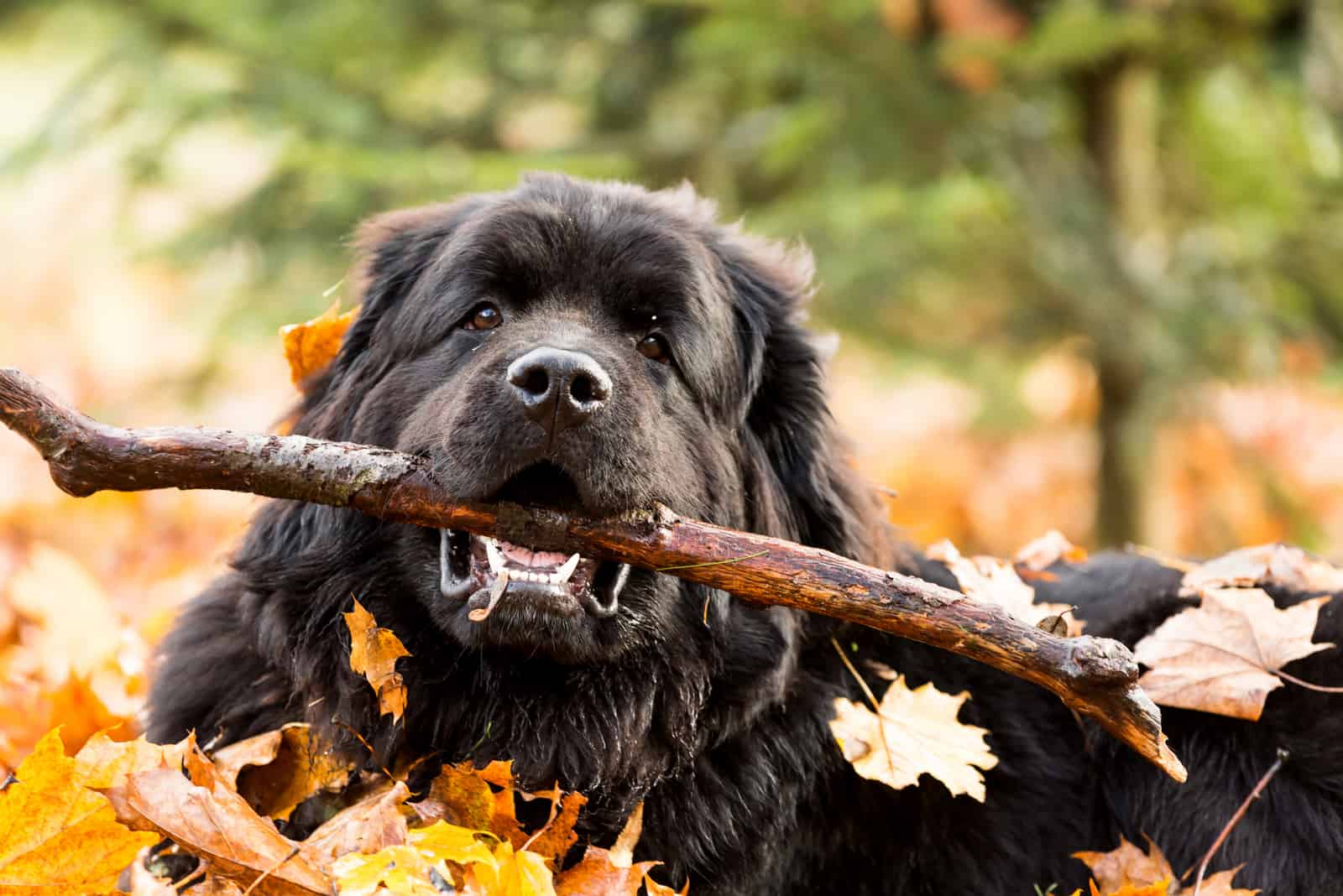
Giant Dog =/= Giant Diet
People love to say that giant dog breeds require irrational amounts of food from the get go. That is simply not true.
A Newfoundland puppy eats twice a day because its stomach can be easily upset with too much food, eaten too fast. That is why slow feeding the right amounts of food is ideal.
Since they grow very rapidly in the first few months, you will make changes to the dosage anyways and soon find yourself reaching for the cup.
There Is More To Food Than Meat
They should eat X amount of meat a day. Well, that is simply wrong. Yes, canines are carnivores and meat should be the main source of calories for them. However, things are a bit more complicated.
Ingredient quality and diversity is much more important than amount. More on this in the next chapter of our article!
Too Big For Creating Havoc
This last myth about Newfoundland dogs is not directly related to feeding but is in close connection with it.
We spoke about levels of activity and adapting the food intake based on it. People believe that Newfoundland dogs are lazy and low-energy because they are giant.
This is absolutely incorrect. The Newfoundland eats a rather large amount of food but for good reason: it has a lot of muscle underneath that fluffy exterior. They were bred to be working dogs.
To keep their muscle mass at an optimal level while being as active as a Belgian Malinois, they would need to have unreasonably fast metabolisms for their size. That is why even the shortest run for a Newf burns a lot of calories.
This still does not mean that they are low-energy. They just need a lot of fuel to be active. That is why your wallet gets emptied on dog food! On that note, let us see what type of food is best and which one is a no-no.
How to Choose The BEST Dog Food
1. Kibble, Raw Food, And Fresh Food
Kibble is great in many ways and not so great in many others. It mostly depends on what climate you live in and if your dog prefers wet or dry dog food.
It is great for easy storage as it does not spoil easily. Put it in the garage, pantry, under the bed, in the shed – it will stay fresh anywhere.
Kibble is still not a complete diet food, despite having “fillers” in their composition. These fillers are supposed to supplement the protein-dominant kibble but are, more often than not, not sufficient.
Raw food is a tricky one. Buying from a butcher’s shop or at the market is not advisable because raw meat can contain bacteria, viruses, or parasites. Do not say we haven’t warned you about that barf.
Try some certified farms for meat, eggs etc. You should bear in mind that this is a difficult and PRICEY dog diet. Find more information in our article on how much raw food to feed a puppy.
Fresh food means cooked food. That’s great, right?! Well it is tough to cook a balanced meal for your dog with only protein and fat. Dogs in the wild eat different types of plants too, they eat bone, marrow and what not.
While you can feel safer about cooking your Newf’s food, it is still pricey, time consuming, and difficult to maintain as the dog grows larger.
2. Protein And Fat Ratio
The perfect meal for your Newfoundland dog is one with lots of protein and some fat. The ratio is usually 10-15% fat to 20-30% protein in a meal. If you are cooking for your dog or feeding it raw food, this is a good way to choose a cut.
3. Read The Ingredient List
Every commercial dog food brand has a list of ingredients written on the back of the container. Read it carefully and your dog will thank you.
Here is a list of things to look for.
1. Healthy Nutrients
We already established that protein is king. You can easily tell how much protein there is if the label reads the type of protein as the first ingredient in the sentence. It is usually poultry, game, beef, or something similar, followed by supplements etc.
There is no good diet without vitamins and minerals. The ones a Newfoundland puppy or adult dog need most are:
– Calcium for strong teeth and bones to disassemble the couch. Recommended daily amount – eg. Hip and elbow dysplasia begone! You can add some bones or broccoli to your dog’s food to reach the daily goal.
– Lutein for the eyes so they can see where you hide the peanut butter. Get some tuna, garlic, broccoli, or carrots and add to your dog’s favorite dish.
– Glucosamine for the joints and cartilage. A nice bone broth, some turkey or chicken tracheas, or animal cartilage will all do the job in providing the right amounts for your Newfoundland.
2. Additives (Fillers)
From puppyhood to adult dog phase, you will switch food brands. The fillers do not necessarily harm the dog but definitely do not contribute positively to a dog’s diet.
They are called that for a reason – the space in the can or plastic bag needed to be filled with something, so why not corn, or some other vegetable in surplus?
However, there are fillers that actually provide some nutritional value to dog food. Some of those include sweet potatoes, carrots, and beet pulp. Learn more on how to cook sweet potatoes for dogs.
Another thing to steer clear of are food dyes, rendered fat, and anything that sounds like it was made in Dexter’s laboratory.
3. Supplements
Since your dog might not like the taste of greens such as broccoli, spinach, or carrots, you can buy supplements in a pet pharmacy. These are concentrated doses of all the previously mentioned vitamins and minerals and probably more.
This is a very convenient option when your dog is on a raw food or fresh food regime.
4. Consider Your Dog’s Preference
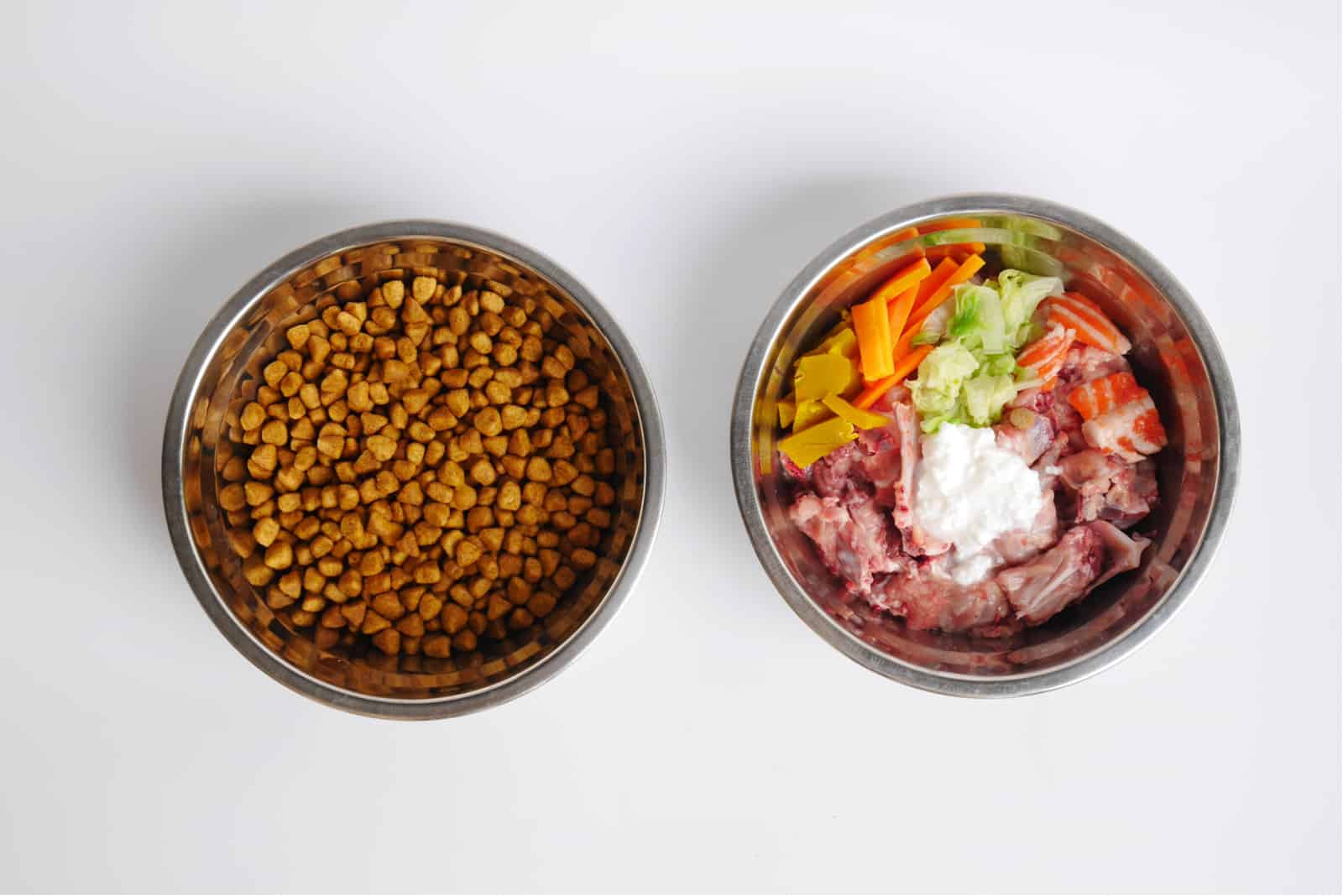
1. Puppy Food
Small teeth and mouth? Well if you are a Newfoundland dog, that is no problem for you. At 8 weeks of age you can munch down whatever comes your way.
You can teach your Newfoundland puppy to like greens and vegetables that are good for their health through activities and by mixing them with their food of choice. You will immediately feel like Gordon Ramsay if your puppy eats that steamed broccoli.
Most puppies will eat any food you give them, some will only eat wet or dry food. It is a trial and error game until you find the right form or brand that your puppy will enjoy.
2. Adult Food
An adult dog can sometimes get bored of the same type of food or brand. Many times, it is hard to notice with an adult dog that it is not delighted by the proposition of more chicken-tasting kibble or game-tasting canned food.
Switch it up, add some cooked meat, bones, black mussels, carrots, or dog spice. Go wild, but not wilder than the dog.
Dog Food DON’TS
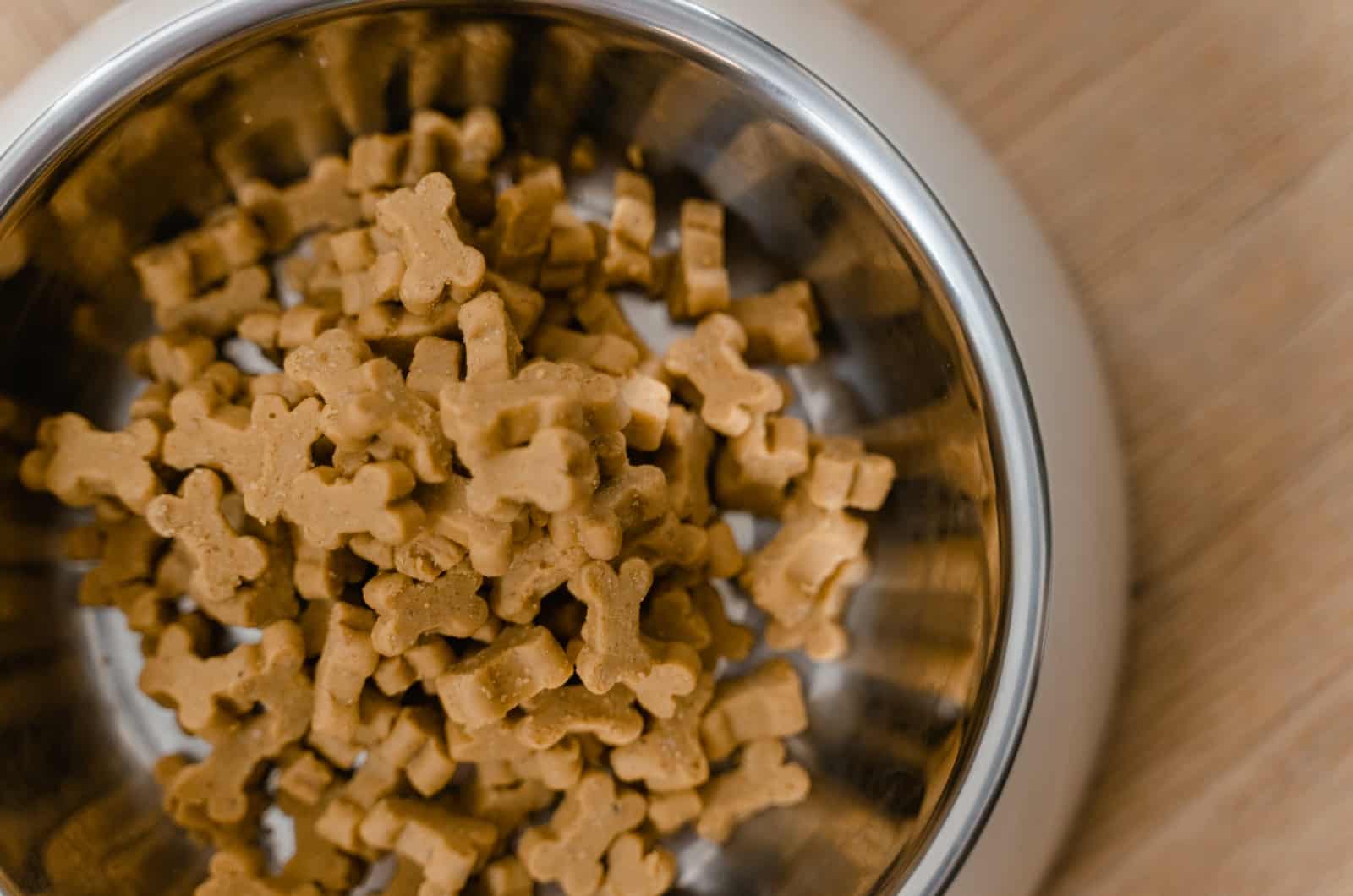
1. Plant-Based
Carnivores eat meat. They do not get many benefits from carbohydrates. Eating foods with lots of starchy or wheat-based fillers will fast-forward your dog’s obesity issues.
Newfoundland puppy foods should definitely not contain additives of such sorts because it might impact their health in the long-run.
2. Low-Quality, Cheap Food
Pet food that comes in extremely large packages is usually low quality food. It will not satisfy the nutritional needs of your newfoundland pups. We just assumed you have more than one. One is never enough!
These foods can be used as occasional treats, but we recommend avoiding them as a main dietary course. Bulk dog food is full of fillers which is reflected in the low cost.
Canned foods are also not ideal due to their low protein to water ratio. A can of dog food may be filled with preservatives and other liquid additives thus lowering the overall nutritional value.
There are brands that make both canned and kibble but at a higher quality and, naturally, cost. A quick Google search will definitely yield a plethora of options.
Wrapping It Up
We are at the end of this article and these are the final words: stay true to the feeding schedule. Monitor your puppy’s growth. Follow the Newfoundland feeding chart and keep track of how much it is eating.
Choose the best food you can afford for your dog. Research and read what others had to say on pet food preferences. Try not to lower the food amount. Instead, promote activity.
Now, have a great time with your Newf and stay fed together.
Read Next: Newfoundland Lifespan And Health Overview (What You Need To Know)
